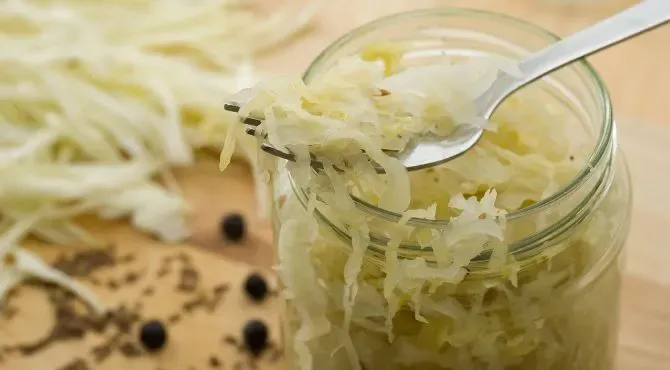Lacto-fermentation: 4 Lacto-fermented foods to get started

4 Fermented Foods You Can Easily Make at Home. Back in force in recent years, Lacto-fermentation is a traditional way of preserving food. It also increases their nutritional benefits and their taste! Fermentation is when micro-organisms such as bacteria or yeasts transform the carbohydrates present in food into acids, gas, or alcohol. Wine, for example, is the result of fermentation of the sugar in grape juice under the action of yeasts.
Best fermented foods for gut health
During Lacto-fermentation (lactic fermentation), the
carbohydrates in the food will be transformed into lactic acid by the lactic
bacteria they contain. Lactose intolerant, do not shun all Lacto-fermented
products! The qualifier lactic simply refers to how lactic acid was first
isolated from milk.
Here are 4 Lacto-fermented foods to introduce to our plates. See you after the list for more details on Lacto-fermentation and its benefits.

Sauerkraut is one of the most consumed Lacto-fermented foods! We use cabbage, to which we add a brine (mixture of water and salt). Rich in probiotics and vitamin C, it contributes to the proper functioning of the immune system. It would have allowed Captain Cook's crews to protect them against scurvy.
How to eat it: sauerkraut can be found raw or cooked. To make your sauerkraut, ferment cabbage with brine in a sauerkraut pot. It can be served with fish (haddock, salmon) and shellfish to make sea sauerkraut or enjoyed in a salad.

Kefir is a drink originating from the Caucasus. A distinction is made between milk kefir produced from animal milk to which yeasts and ferments are added. And fruit kefir is made from fruit, water, sugar, and water kefir grains. This study shows that a genuine concentrate of lactic acid bacteria, kefir, has a probiotic effect.
How to consume it: you can find milk kefir in many stores. To soften its slightly sour flavor, you can add a natural syrup or honey. There is also powdered kefir or kefir grains to make your beverages.

Natural sourdough is obtained from the fermentation of cereals. Traditionally it is made from wheat or rye flour, and following the addition of water and salt, fermentation begins. Fermentation would generate antioxidants and prebiotic compounds, as suggested by this study.
How to consume it: we recommend consuming natural sourdough bread made from organic flour. The preparation begins with a "starter" made up of water and flour, and then feed the preparation with a mixture of water and flour, and the mixture will start to bubble and smell sour.

Miso is a key ingredient in Japanese cuisine, made from a fermented soybean paste. Soy miso is a complete plant protein source, and its fermentation is accompanied by an increase in the probiotics population, which promotes good digestive health.
How to consume it: its taste is called umami (fifth flavor). It is found in Japanese grocery stores and organic stores, and it can use to season meats in soups, broths, or wok dishes.

Fish is also a good candidate. This is the case, for example, of the nuoc mam sauce, widely used in Asian cuisine. It comes from the fermentation of fish in brine (a mixture of water and salt).
During Lacto-fermentation, the lactic bacteria naturally present on the surface of the food will nibble the sugars and transform them into lactic acid. This reaction leads to an increase in the population of lactic acid bacteria and an increase in the medium's acidity. This action occurs in a medium devoid of oxygen.
During Lacto-fermentation, the populations of lactic acid bacteria will increase in food. This will constitute a probiotics (good bacteria) reservoir beneficial to our microbiota. These bacteria have many benefits, such as strengthening the immune system or an anti-inflammatory role.
Lacto-fermentation makes food more digestible. For example, it lowers the amount of lactose in milk kefir. In addition, the fibers of Lacto-fermented vegetables are as if predigested by lactic acid bacteria, which makes them more easily assimilated by the body. By Lacto-fermenting vegetables rich in prebiotics, we provide the body with fibers that constitute the fuel for our good intestinal bacteria.
Here are 4 Lacto-fermented foods to introduce to our plates. See you after the list for more details on Lacto-fermentation and its benefits.
1. Sauerkraut

Sauerkraut is one of the most consumed Lacto-fermented foods! We use cabbage, to which we add a brine (mixture of water and salt). Rich in probiotics and vitamin C, it contributes to the proper functioning of the immune system. It would have allowed Captain Cook's crews to protect them against scurvy.
How to eat it: sauerkraut can be found raw or cooked. To make your sauerkraut, ferment cabbage with brine in a sauerkraut pot. It can be served with fish (haddock, salmon) and shellfish to make sea sauerkraut or enjoyed in a salad.
2. Kefir

Kefir is a drink originating from the Caucasus. A distinction is made between milk kefir produced from animal milk to which yeasts and ferments are added. And fruit kefir is made from fruit, water, sugar, and water kefir grains. This study shows that a genuine concentrate of lactic acid bacteria, kefir, has a probiotic effect.
How to consume it: you can find milk kefir in many stores. To soften its slightly sour flavor, you can add a natural syrup or honey. There is also powdered kefir or kefir grains to make your beverages.
3. Natural Sourdough Bread

Natural sourdough is obtained from the fermentation of cereals. Traditionally it is made from wheat or rye flour, and following the addition of water and salt, fermentation begins. Fermentation would generate antioxidants and prebiotic compounds, as suggested by this study.
How to consume it: we recommend consuming natural sourdough bread made from organic flour. The preparation begins with a "starter" made up of water and flour, and then feed the preparation with a mixture of water and flour, and the mixture will start to bubble and smell sour.
4. Miso

Miso is a key ingredient in Japanese cuisine, made from a fermented soybean paste. Soy miso is a complete plant protein source, and its fermentation is accompanied by an increase in the probiotics population, which promotes good digestive health.
How to consume it: its taste is called umami (fifth flavor). It is found in Japanese grocery stores and organic stores, and it can use to season meats in soups, broths, or wok dishes.
Lacto-fermentation, bacteria that transform sugars

What is Lacto-fermentation?
Most vegetables are among the foods eligible for Lacto fermentation, such as the famous sauerkraut! Fruit is rarely used. Indeed, you have to learn how to appreciate their taste after the Lacto-fermentation, slightly vinegary and salty. Another example of Lacto-fermented products is fermented milk products like kefir. Cereals can also undergo this kind of transformation (bread leaven).Fish is also a good candidate. This is the case, for example, of the nuoc mam sauce, widely used in Asian cuisine. It comes from the fermentation of fish in brine (a mixture of water and salt).
During Lacto-fermentation, the lactic bacteria naturally present on the surface of the food will nibble the sugars and transform them into lactic acid. This reaction leads to an increase in the population of lactic acid bacteria and an increase in the medium's acidity. This action occurs in a medium devoid of oxygen.
Benefits of Lacto-fermentation
Lacto-fermentation is a fantastic reaction! Indeed, it increases the number of certain nutrients in food. This study on the nutritional quality of bitter melon and fermented fenugreek leaves showed an increase in vitamin C and vitamin B12 compared to natural vegetables.During Lacto-fermentation, the populations of lactic acid bacteria will increase in food. This will constitute a probiotics (good bacteria) reservoir beneficial to our microbiota. These bacteria have many benefits, such as strengthening the immune system or an anti-inflammatory role.
Lacto-fermentation makes food more digestible. For example, it lowers the amount of lactose in milk kefir. In addition, the fibers of Lacto-fermented vegetables are as if predigested by lactic acid bacteria, which makes them more easily assimilated by the body. By Lacto-fermenting vegetables rich in prebiotics, we provide the body with fibers that constitute the fuel for our good intestinal bacteria.
Lacto-fermentation, what precautions?
Lacto-fermentation requires certain precautions. In particular, you must wash your hands carefully, use utensils that close hermetically and respect the fermentation times. Experts can assist you in the realization of your recipes.Read More:
Post a Comment